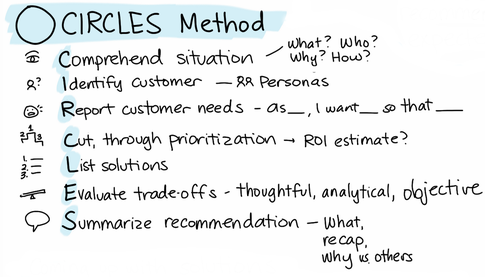
What is the Circles Method?
Created by Lewis C. Lin, the CIRCLES method is a framework that aims at helping product managers to provide well-thought-out responses to product design questions. It enables you to provide the right responses to questions that interviewers commonly use to assess the abilities of Product Managers.
You may think of this framework as a memory aid for acing product design interviews. “CIRCLES” is an acronym for the seven steps to follow for providing thoughtful responses to questions. The steps are:
- Comprehend the situation
- Identify the Customer
- Report the customer’s needs
- Cut, through prioritization
- List solutions
- Evaluate tradeoffs
- Summarize recommendation
This framework provides a structure both for asking the right product design questions and for answering them convincingly.
How is the CIRCLES Method Helpful?
During product design interviews, interviewers are looking to assess the ability of product managers to define objectives and empathize with customers. They are also trying to evaluate how well Product Managers can express customer problems as well as brainstorm and prioritize ideas.
The CIRCLES is quite helpful to product management. It assists product managers in:
- Identifying whom a product or feature is targeted at to help maintain full focus on these customers
- Prioritizing the product roadmap, features, development work, and feedback
- Explaining to stakeholders why something is worth building
- Ensuring they have ample information on possible solutions to problems before opting for one
The framework highlights a series of steps that a PM should consider taking when dealing with product design. It, therefore, reduces the risk of making decisions that are not ideal. For product design interviews, it helps to know what should be considered or the elements that should feature in the responses provided.
CIRCLE Method Steps
Comprehend the situation
When faced with a product design question, the CIRCLES Method creator advises seeking as much information as you can. This enables you to better grasp the situation so that you can respond more aptly.
Lin suggests asking what are called the “5 W’s and H” questions, which are:
- What is it?
- Who is it for?
- Why do they need it?
- When is it available?
- Where is it available?
- How does it work?
However, the most important ones to ask are the “what,” “who,” “why,” and “how” questions.
This step is basically about understanding the goal, context, and constraints. You may make an educated guess if an interviewer won’t answer some of your questions.
Identify the customer
You should be ready to suggest a great product during an interview. To succeed at that, it is critical to know who the customers are.
Come up with different personas of customers you can provide a solution for. You will need to put yourself in the customer’s position to know what matters more to them.
Apart from identifying the customer, you must understand their personality and goals. What are their demographics and peculiar behaviors?
Report customers’ needs
Having identified your customers, you now want to report their needs. These are also called user requirements or use cases.
The reporting is done from the user’s perspective. In many cases, it takes the form of user stories that put across what the user wants to be able to do in simple language.
User stories typically take the form, “As a <type of user>, I want <goal> so that <some benefit>.
Cut, through prioritization
Evaluate the needs of customers and identify the one that is most important to tackle. There may be more than one use case, but you should choose just one to take on first.
There may not be enough time to go over all use cases during an interview. You have to just select one based on what you consider the most important – user experience, ease of execution, revenue, or any other consideration.
List solutions
For whatever user need you selected, come up with possible solutions. There is often more than one way to deal with a problem.
Lin uses an example of wanting to help customers deal with junk mails. Possible solutions include a global do-not-mail list, SMS opt-out, and an opt-out camera app.
Try to come up with at least three possible solutions.
Evaluate tradeoffs
Whatever solutions you identify will usually have pros and cons. You want to point these out to the interviewer.
Having predefined criteria will help with your solution evaluations. These can include revenue, user satisfaction, and ease of execution.
Drawing attention to tradeoffs can help to portray you as an analytical, attentive, and objective person.
Summarize recommendation
The final step is to provide a summary of your recommendation. This may be optional in some cases.
Tell your interviewer what product you’d recommend. Let them know why you think it is helpful to the customer and/or the organization. Also, point out why the solution is preferable to alternatives.
Making it Work Better
Without a structure, what you say may be incoherent and less-persuasive. The CIRCLES Method provides you a framework that enables you to be more convincing.
It can be quite tough dealing with product design questions effectively without having a solution in mind. You may find things a lot easier by having one already in focus and then cleverly driving your talk towards it.
We must emphasize that the CIRCLES Method is intended more as a mental cue. All steps are not compulsory – only use the ones you consider most helpful.



